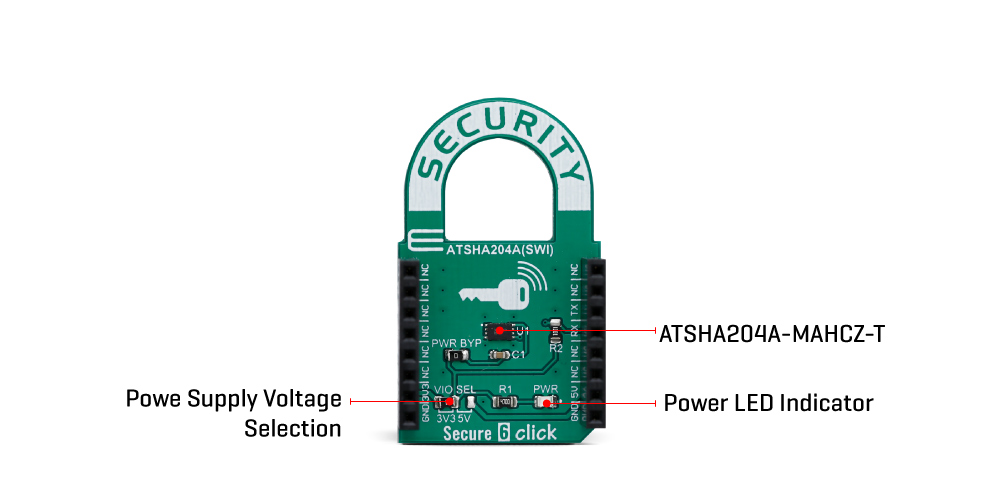



Overview
The Secure 6 Click Board™ includes the ATSHA204A, a secure CryptoAuthentication™ device from Microchip, which is equipped with an EEPROM array that can be used for storing up to 16 keys, certificates, consumption logging, security configurations and other types of secure data. The ATSHA204A equipped on this Click Board™ supports the SWI interface with a flexible command set, that allows use in various security applications, including Network/IoT Node Endpoint Security, Secure Boot, Small Message Encryption, Key Generation for Software Download, Ecosystem control, Anti Counterfeiting and similar.
The Secure 6 Click Board™ is supported by a mikroSDK compliant library, which includes functions that simplify software development. This Click Board™ comes as a fully tested product, ready to be used on a system equipped with the mikroBUS™ socket.
NOTE: The Click Board™ comes with stacking headers which allow you to combine it with other Click Board™ boards™ more easily by using just one mikroBUS™ socket.
Downloads
The Secure 6 Click Board™ includes the ATSHA204A, a secure CryptoAuthentication™ device from Microchip, which is equipped with an EEPROM array which can be used for storing of up to 16 keys, certificates, consumption logging, security configurations and other types of secure data. Access to the various sections of memory can be restricted in several different ways and then the configuration can be locked permanently, to prevent changes. The ATSHA204A equipped on this click board™, supports the SWI interface with a flexible command set, that allows use in various security applications, including Network/IoT Node Endpoint Security, Secure Boot, Small Message Encryption, Key Generation for Software Download, Ecosystem control, Anti Counterfeiting and similar.
How Does The Secure 6 Click Board™ Work?
The ATSHA204A implements a complete asymmetric key cryptographic signature solution, based on the Elliptic Curve Cryptography and the ECDSA signature protocol. It also implements AES-128, SHA256 and multiple SHA derivatives, such as HMSC(SHA), PRF (the key derivation function in TLS) and HKDF in hardware. It can also generate random private keys and random numbers, which can be used as a part of the crypto protocol.

Those asymmetric cryptographic operations are accelerated by the ATSHA204A hardware and are calculated up from ten to thousand times faster than with the software running on standard microprocessors. This prevents the risk of key exposure, which is usually found in standard microprocessors.
The device is consuming very low current, especially while it is in the sleep mode. The chip itself uses less than 150nA, in that case. The voltage range which can be used to power up the Security 6 click, allows for it to work with both 3.3V and 5V capable MCUs. Therefore, this click board™ supports the parasitic power supply mode, where the main IC is powered via the communication line. When the onboard jumper PWR BYP is removed, Secure 6 click
The chip itself uses a minimal number of pins; only the SWI lines are routed to the mikroBUS™ along with the 3.3V and 5V rails. The device can work with any of these voltages. It can be selected by soldering a small SMD jumper, labelled as VIO SEL to the correct position.
IMPORTANT: On the Secure 6 Click Board™, UART lines (RX and TX) are shorted and pulled high by the 1KΩ resistor. Basically, they act as a single line and only one trace is routed to the ATSHA204A IC. Further it means that UART pins can be used only for SWI communication when this click board™ is used on a system.
SPECIFICATIONS
| Type | Encryption |
| Applications | The Secure 6 Click Board™ can be used for storage of up to 16 keys, certificates, miscellaneous read/write, read-only or secret data, consumption logging, and security configurations |
| On-board modules | Microchip ATSHA204A IC which includes an EEPROM array |
| Key Features | Cryptographic Co-processor with secure hardware-based key storage for up to 16 keys, certificates or data. Hardware support for the asymmetric sign, verify, key agreement, unique 72-bit serial number, Single Wire Interface (SWI). |
| Interface | SWI |
| Compatibility | mikroBUS |
| Click board size | M (42.9 x 25.4 mm) |
| Input Voltage | 3.3V or 5V |
PINOUT DIAGRAM
This table shows how the pinout of the Secure 6 Click Board™ corresponds to the pinout on the mikroBUS™ socket (the latter shown in the two middle columns).
| Notes | Pin |  |
Pin | Notes | |||
|---|---|---|---|---|---|---|---|
| NC | 1 | AN | PWM | 16 | NC | ||
| NC | 2 | RST | INT | 15 | NC | ||
| NC | 3 | CS | RX | 14 | TX | SWI Line | |
| NC | 4 | SCK | TX | 13 | RX | SWI Line | |
| NC | 5 | MISO | SCL | 12 | NC | ||
| NC | 6 | MOSI | SDA | 11 | NC | ||
| Power Supply | 3.3V | 7 | 3.3V | 5V | 10 | 5V | Power supply |
| Ground | GND | 8 | GND | GND | 9 | GND | Ground |
ONBOARD SETTINGS AND INDICATORS
| Label | Name | Default | Description |
|---|---|---|---|
| LD1 | PWR LED | - | Power LED Indicator |
| JP1 | VIO SEL | Left | Power supply voltage selection, left position 3V3, right position 5V |
| General Information | |
|---|---|
Part Number (SKU) |
MIKROE-3699
|
Manufacturer |
|
| Physical and Mechanical | |
Weight |
0.018 kg
|
| Other | |
Country of Origin |
|
HS Code Customs Tariff code
|
|
EAN |
8606018716647
|
Warranty |
|
Frequently Asked Questions
Have a Question?
Be the first to ask a question about this.




